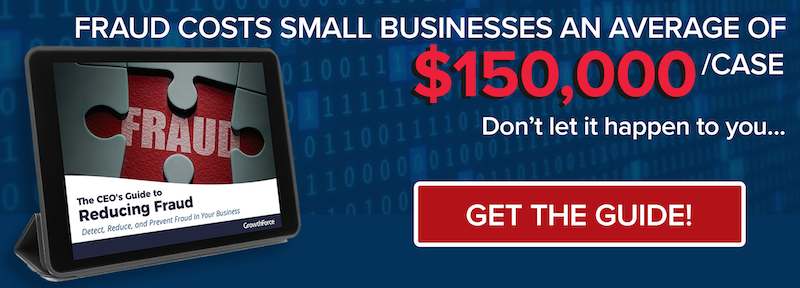$62,000 Median Loss Per Case in Payroll Fraud
While payroll fraud only accounts for 9 percent of cases, the median loss per case amounts to $62,000. Because the amounts are so great, payroll fraud warrants special attention.
 The fact that many small businesses typically lack internal controls makes them an easy target. There are quite a few ways employees commit payroll fraud:
The fact that many small businesses typically lack internal controls makes them an easy target. There are quite a few ways employees commit payroll fraud:- a fraudster may increase the number of hours or overtime worked on their timesheet.
- An employee who has access to payroll can inflate their wages
- or issue salaries to so-called ghost employees: company employees who only exist on paper.
It may be a red flag if an in-house bookkeeper insists on doing payroll. It doesn't make sense for a bookkeeper to control this function since outsourcing payroll costs less than doing it in-house and it helps reduce fraud.
While the size of the organization is certainly a factor if payroll is done in-house, this type of fraud can impact both small and large businesses when it comes to employees tracking and logging their hours worked. Therefore, extra attention must be paid towards establishing a system of review to reduce the likelihood of false compensation claims.
Here is one example of a common Payroll Fraud scenario...
Payroll Manipulation
An interior designer had a bookkeeper who “did everything.” And it was precisely because he wore all the hats in the accounting department that he found a way to steal without getting caught.
The bookkeeper had editing rights to the  "year-to-date payroll changes" inside QuickBooks™. That meant he could change the amount shown as his payroll tax withholdings to an amount that was higher than what was actually withheld. The extra amount was then paid by the company through a higher payroll tax deposit.
"year-to-date payroll changes" inside QuickBooks™. That meant he could change the amount shown as his payroll tax withholdings to an amount that was higher than what was actually withheld. The extra amount was then paid by the company through a higher payroll tax deposit.
Because payroll tax withholdings are the amount an employer withholds and remits to the IRS on behalf of each employee, and that amount differs per employee, it wasn’t difficult to conceal the additional funds.
After padding the amount of taxes deposited, the bookkeeper altered his tax withholdings on his W-2 and changed the payroll tax return. And that meant that at the end of the fiscal year, he could claim a higher tax refund.
Because the bookkeeper did everything, the CEO would never have detected the theft unless someone reviewed the payroll tax adjustments. Fortunately, the client brought our team in, and we were able to uncover the payroll fraud. You should not handle payroll inhouse. The risk is great and the cost to outsource it is very low.
OutSmart Fraud with Internal Controls
- Outsource payroll and require owner/manager approval on payroll changes
- Separate duties: create, review/approve/sign payroll
- Encourage direct deposit or pay cards (no checks to steal)
- Separate bank reconciliation from payroll processing
- Set up positive pay for payroll
- Set up ACH filters
- Set up user rights to restrict the ability to edit payroll transactions
- Review payroll change reports; gross wages, W-2s
- Background checks
The most frequently occurring type of fraud in small businesses is billing fraud, which amounts to 27.1 percent of all cases.
Read on about How to Prevent Billing Fraud...
Statistical Source: ACFE 2020 Report to the Nations on Occupational Fraud and Abuse (http://www.acfe.com)

.png?width=2000&height=440&name=Transitional%20GF%20Logo%20-%20Transparent%20(1).png)


